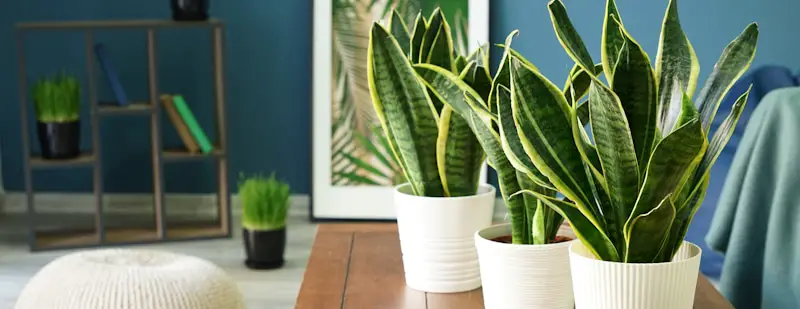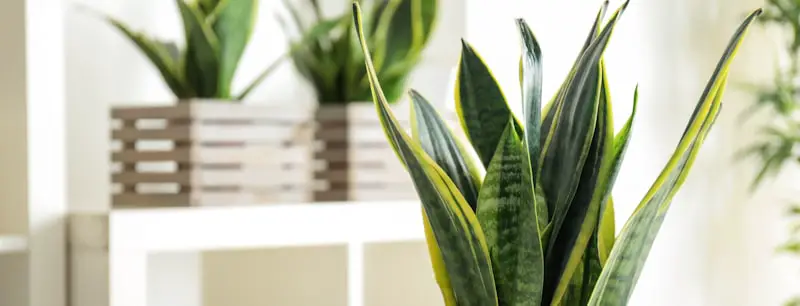Even though snake plants have a record for being nearly impossible to kill, they nonetheless experience a fair share of issues. You are not the only one who has noticed that your snake plant’s leaves are turning yellow. We will examine the reasons snake plant leaves turn yellow and how to deal with it.
Root disease and overwatering are the main causes of snake plant leaves being yellow. Additional factors contributing to leaf yellowing include insect infestation, overfertilization, excessive sunshine exposure, and underwatering. The plant should be repotted in fresh, drained soil.
Snake plants often turn yellow at the edges of their vertical and broad leaves; however, this issue is usually caused by neglect of the plant. The significant discoloration is a key indicator of poor upkeep and should be fixed as soon as feasible.
Yellow Snake Plant
Snake plant leaves becoming yellow is typically a sign of an inadequate watering schedule, typically brought on by overwatering but can also result from poor watering habits in general. So let us look at general care advice and the best way to water to stop snake plant leaves from turning yellow.
First and foremost, you must let your plant dry out in between waterings. Since snake plants are prone to root rot, they will not thrive if watered excessively. This is typically the ideal balance if you let your plant dry out but do not let it stay dry.
You can water your plant again as soon as the soil seems dry to the touch. It is crucial to test the soil moisture by sticking your finger in to examine the top layer. A wet container will weigh substantially heavier than a dry pot, so eventually, you ought to be able to determine how dry your crop is based on the mass of its container.
Snake plant leaves may become yellow if you let your plant dry out, then wait until the soil is completely dry before rewatering. Avoid going from a drought to a flood by waiting until it is dry before giving your plant light watering. You need to consider more than just how often you water snake plants.
You also must consider what occurs to the liquid when it is placed in the pot. After watering your plant, you should not let the roots linger in water for a few days because this can cause root rot. Water must circulate easily into the potting mix and leave through the bottom to ensure that the plant only absorbs what it needs.
You must consider your potting mix and the container you use to do this. Endeavor to use a light, balanced potting mix suitable for succulents and cacti, and consider adding perlite to aid in aeration. Next, make certain that the pot you use has a discharge hole. Since they draw moisture away from roots and directly into the pot, terracotta pots are ideal for growing snake plants.
Snake Plant Turning Yellow And Soft
Several factors might cause the leaves of snake plants to become yellow; these include excessive fertilizer use, exposure to freezing weather, and overwatering. Yellowing leaves can be treated by giving the snake plant the right surroundings and attention. Below are some of the reasons snake plants turn yellow and soft.
Overwatering
You are essentially setting up your snake plant for death when you overwater it. If your plants start to turn yellow, something is wrong with your care. It is time to concentrate on your watering routine and act quickly to save the snake plant; root rot can result from overwatering.
You only need to offer enough supply and ensure correct drainage to allow the extra water to drain out. Not too much nor too little; there will be a suitable environment for fungi illnesses if there is any standing water. The snake plants can be watered every two to six weeks. You can also observe whether the earth seems dry.
Lack of Water
You may be excessively busy with life, after all. You might also have read or heard that a snake plant can live for a very long period without water. Alternatively, perhaps you were on vacation. In any event, insufficient underwatering will exhibit certain overwatering’s signs.
When a plant is underwatered, its root system cannot efficiently conduct physiological functions due to a lack of water and nutrients. Therefore, your snake plant cannot utilize the nutrients in the soil without water; underwatering dehydrates the plant and results in the yellowing of the foliage.
Why Snake Plants Turn Brown And Yellow?
Sansevieria trifasciata, sometimes known as snake plants, are exceptionally easy to cultivate and require very little maintenance if you are looking for solutions to the problem of your snake plant becoming yellow and brown. However, if these crops are not grown in an optimum environment or are not given the right nutrients, they begin to exhibit inconsistent symptoms.
The yellowing of leaves is one example; you can fix this, but first, you must understand why it occurs. The primary cause of snake plant leaves becoming yellow and brown is overwatering and persistently wet soil. Additionally, snake plants’ foliage turns yellow due to nutrient deficiency.
The snake plant’s leaves can go yellow from the edges of the lower center due to various issues. If the soil is not altered, that could be the cause as the soil starts to harden, and too much water leads to root rot.
You must cease watering the snake plant more frequently and allow it to dry out fully in the sun or shade if you want to save it. You can transfer it to a new pot using fresh potting soil if it does not work. Giving your snake plant a warmer location and watching out for overwatering are two ways to keep negative things from happening.
These plants may grow beautifully in this indirect, bright light because they adore it. The early sun does not affect their ability to bear it or their leaves. After placing them in the morning sun, you will notice that snake plants’ growth rate would increase and appear healthier.
However, placing them in the outdoor morning sunlight will need more water, so once per week is sufficient. However, if the area receives excessive sunlight and the surface feels dry, you can water them twice per week.
Snake Plant With Yellow Edges
One of the simplest indoor plants to maintain is the snake plant, which accounts for its widespread use. They are hardy plants that require minimal upkeep, and they also have a distinctive appearance that gives any space personality and color. Below are some causes of snake plants with yellow edges.
Overexposure to Sunlight
While snake plants benefit from sunlight, some gardeners go overboard and position their plants in an area that receives intense sunlight. The leaves can start to burn if they receive too much direct sunshine, turning them yellowish-brown. Once the plant is placed close to a window, the glass might have a magnification effect that intensifies the light on particular leaf areas, leading to overexposure.
Frequent Temperature Fluctuations
Snake plants, like the majority of indoor plants, suffer when subjected to significant temperature changes. Despite being reasonably hardy indoor plants, they suffer when subjected to abrupt and extreme temperature changes. These abrupt fluctuations can put the plant under much stress and result in the yellowing of the leaves.
Final Thoughts
Despite the hardiness of snake plants, if you detect yellowing leaves on your plant, do not panic. The leaves of snake plants can become limp and yellow for various reasons. You can partially solve the problem by knowing the potential reasons. You can develop a workable solution and assist your plant in getting back to its green state based on the pertinent cause.
Victoria is the owner and main author of hobby plants. She loves spending her free time in her garden planting and taking care of her plants. Victoria hopes you enjoy the content here!


![Why Are My Orchid Leaves Turning Yellow? [Find Out Here] Why Are My Orchid Leaves Turning Yellow? [Find Out Here]](https://www.hobbyplants.com/wp-content/uploads/2022/07/orchid-leaves-turning-yellow-300x158.jpg)
![Why Is My Bamboo Plant Turning Yellow? [Find Out Here] Why Is My Bamboo Plant Turning Yellow? [Find Out Here]](https://www.hobbyplants.com/wp-content/uploads/2022/07/why-is-my-bamboo-turning-yellow-300x158.jpg)
![Why Are My Peace Lily Leaves Turning Brown? [EXPLAINED] Why Are My Peace Lily Leaves Turning Brown? [EXPLAINED]](https://www.hobbyplants.com/wp-content/uploads/2022/07/peace-lily-leaves-turning-brown-1-300x158.jpg)
![Why Is My Aloe Plant Turning Brown? [FIND OUT HERE] Why Is My Aloe Plant Turning Brown? [FIND OUT HERE]](https://www.hobbyplants.com/wp-content/uploads/2022/07/why-is-my-aloe-plant-turning-brown-300x158.jpg)
![Why Is My Fiddle Leaf Fig Dropping Leaves? [ANSWERED] Why Is My Fiddle Leaf Fig Dropping Leaves? [ANSWERED]](https://www.hobbyplants.com/wp-content/uploads/2022/06/why-is-my-fiddle-leaf-fig-dropping-leaves-300x158.jpg)
![Why Are My Bird of Paradise Leaves Curling? [FIND OUT HERE] Why Are My Bird of Paradise Leaves Curling? [FIND OUT HERE]](https://www.hobbyplants.com/wp-content/uploads/2022/07/bird-of-paradise-leaves-curling-300x158.jpg)

![Why Does My Majesty Palm Have Brown Tips? [EXPLAINED] Why Does My Majesty Palm Have Brown Tips? [EXPLAINED]](https://www.hobbyplants.com/wp-content/uploads/2022/08/majesty-palm-brown-tips-300x158.jpg)
![How Often Do You Water A Snake Plant? [FIND OUT HERE] How Often Do You Water A Snake Plant? [FIND OUT HERE]](https://www.hobbyplants.com/wp-content/uploads/2022/07/how-often-do-you-water-a-snake-plant-1-300x158.jpg)
![How To Propagate Snake Plant? [BEGINNER'S GUIDE] How To Propagate Snake Plant? [BEGINNER'S GUIDE]](https://www.hobbyplants.com/wp-content/uploads/2022/08/how-to-propagate-snake-plant-300x158.jpg)
![How to Repot A Snake Plant? [STEP BY STEP GUIDE] How to Repot A Snake Plant? [STEP BY STEP GUIDE]](https://www.hobbyplants.com/wp-content/uploads/2022/08/how-to-repot-snake-plant-300x158.jpg)
![Can Snake Plants Live Outside? [COMPLETE CARE GUIDE] Can Snake Plants Live Outside? [COMPLETE CARE GUIDE]](https://www.hobbyplants.com/wp-content/uploads/2022/08/can-snake-plants-live-outside-300x158.jpg)